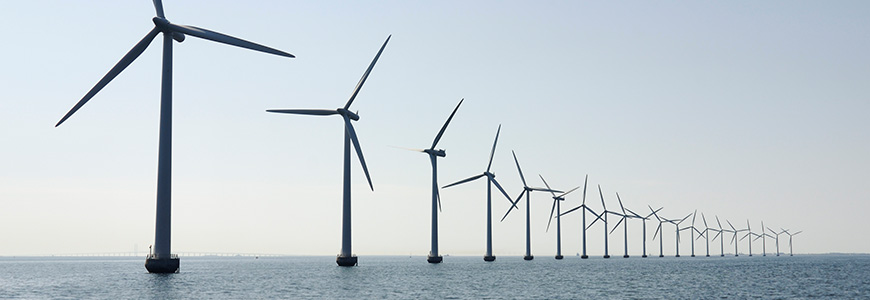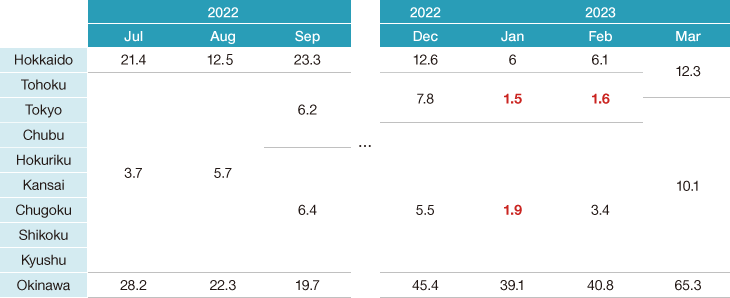August 2022
Green Transformation in Japan Likely to Accelerate toward Year-End

On July 27, the Cabinet Secretariat held a meeting of its GX Implementation Council. We think the council will play the central role in defining Japan's GX-related policies. Key topics discussed at the meeting included: (1) the measures needed to reestablish stable sources of energy; and (2) the roadmap for decarbonizing Japan's economy, society, and industrial structure over the next decade.
(1) Measures Needed to Reestablish Stable Sources of Energy
While electricity shortages have eased versus June following moves such as restarting aging thermal plants, they remain a major concern in winter.
Summer and winter electricity demand and reserve margins (FY2022)

Note: Shows periods of most extreme weather. 3% minimum reserve margin required for stable supply; levels below 3%shown in red/bold.
Source: Nomura, based on Cabinet Secretariat data
The government has identified five factors behind these shortages and will move next to discussing measures to address them. We expect policies to promote renewable energy, storage batteries, and energy efficiency and progress with identifying the items that require political decisions, such as the restart of nuclear plants.
Five Factors behind Electricity Shortages
- Delays with creating business environment needed to avoid shortages in deregulated electricity market
- Delays with restarting nuclear plants
- Impact of accelerating global decarbonization
- Reduction in supply caused by frequent natural disasters
- Greater-than-expected increase in demand caused by weather conditions
Source: Nomura, based on Cabinet Secretariat data
(2)Ten-Year Roadmap for Decarbonization
The council also outlined five initiatives included in theme (2), the ten-year roadmap for decarbonization. We expect it to firm up the specifics of these initiatives by end-2022. These five initiatives are all key themes, but we focus in particular on: (1) the launch of GX Economy Transition Bonds (provisional name); (3) the phased development and deployment of the GX League; and (5) international development strategies, including the Asia zero-emissions community concept. This is because they are closely related to the form of fiscal incentives (carbon pricing) and the global cooperation required for carbon neutral.
Five Initiatives Subject to Carbon-Neutral Roadmaps
- (1)New GX Economy Transition Bond framework (provisional name): firm up specifics of growth-oriented carbon pricing concept
- (2)Measures to promote investment that combines regulations and support: effective and efficient implementation of measures to support growth
- (3)Phased development and deployment of GX League: approach to implementing emissions trading in GX League
- (4)Use of new financing tools: consider initiatives for increasing green/transition/innovation finance projects
- (5)International development strategies, including Asia zero-emissions community concept: cooperate on innovation with developed nations, strengthen collaborative framework by realizing Asia zero-emissions community concept
Note: Details under each initiative are examples of key associated themes.
Source: Nomura, based on Cabinet Secretariat data
For instance, the key point regarding transition bonds will be discussions on the source of funding for bond redemptions. The government's simulation indicates a need for ¥150trn in public- and private-sector investment to reach carbon neutral, of which ¥20trn will come from these transition bonds. Dividing this ¥20trn by 10 years implies a need for ¥2trn in annual funding. This is equivalent to a nearly 1ppt increase in consumption tax, and is by no means a small amount. It could conceivably be funded by emissions trading schemes and carbon taxation, and we will be watching whether the GX Implementation Council discusses specific sources of funding.
A key point of interest here is theme (3), the phased development and deployment of the GX League. The league is defined as a joint industry/public sector/academic framework for developing companies that can successfully compete on the global stage, and 440 companies have already announced their participation. The league involves several initiatives, but we see emissions trading as the key focus. The Japanese government has already made progress with carbon pricing initiatives in response to global moves to decarbonize. The TSE is scheduled to begin proof-of-concept testing of its new carbon credit market in September. This will create a marketplace for carbon credits, replacing the current mainly bilateral transactions.
Lastly, on the international development strategies such as the Asia zero-emissions community concept in point (5), we think attention will increasingly focus on international developments relating to trade and technology cooperation. Southeast Asia will likely be a particular focus from a geopolitical perspective. The US-led Indo-Pacific Economic Framework for Prosperity (IPEF) could develop into an important prototype for international cooperation in the age of decarbonization and ESG. The fact that Japan's foreign minister is a member of the GX Implementation Council also indicates an awareness of international cooperation. We will be monitoring the potential for a deeper debate by the Council on the form that Asia-Pacific regional decarbonization and ESG initiatives should take, with a focus on Southeast Asian nations.
Summary from “Nomura ESG Monthly (August 2022)”



